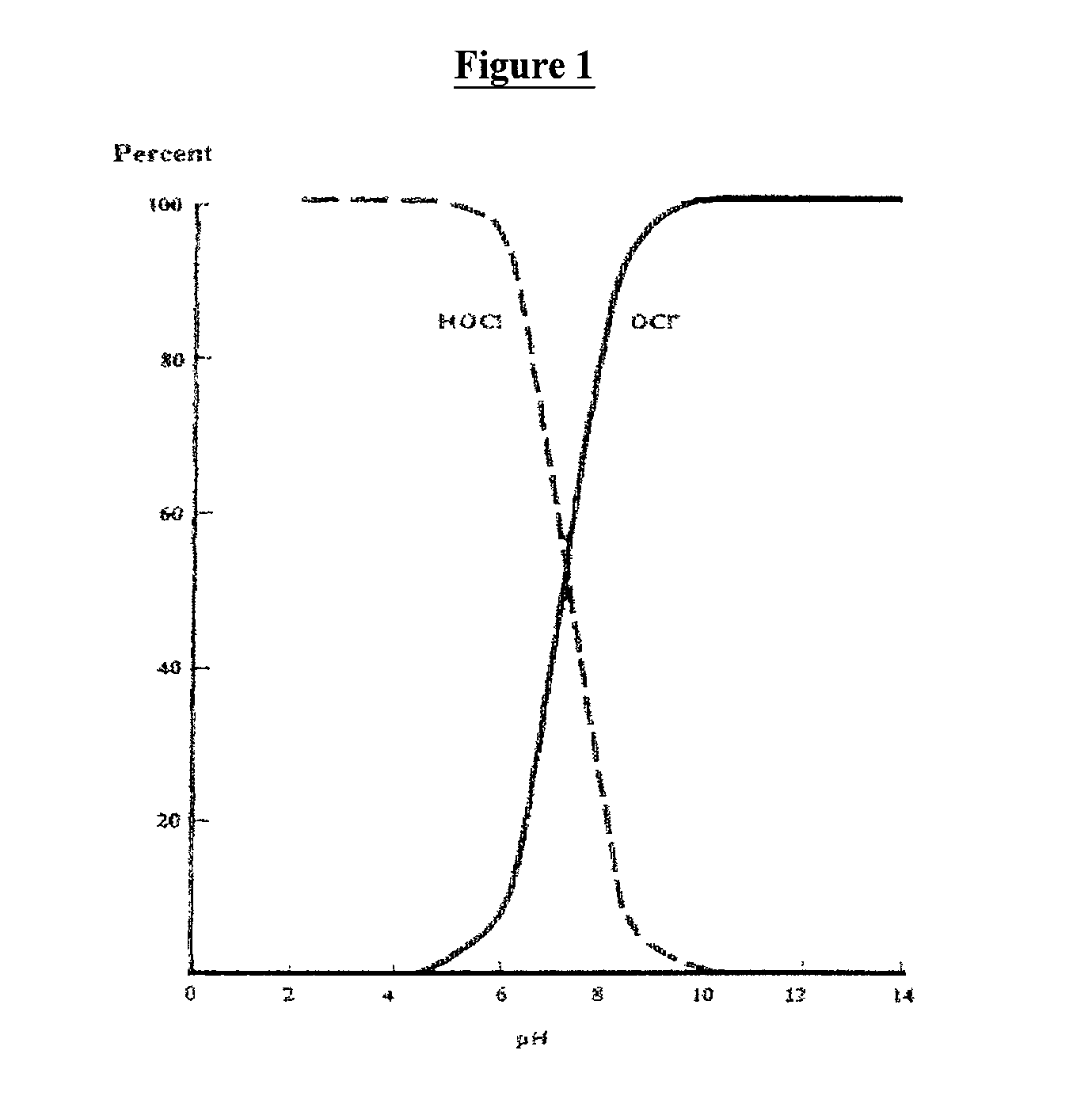Color stable hypochlorous sanitizer and methods
a color stable, sanitizer technology, applied in the direction of inorganic non-surface active detergent compositions, other chemical processes, applications, etc., can solve the problems of substantial decolorization of the solution, inability of dishwashing or kitchen personnel to know when to change the chlorine depleted solution, substantial waste of materials, time and money, etc., to achieve the effect of increasing the ability to sanitize the surface of the ware, reducing the strength or capacity of the solution to sani
- Summary
- Abstract
- Description
- Claims
- Application Information
AI Technical Summary
Benefits of technology
Problems solved by technology
Method used
Image
Examples
example i
[0063]
2 Powdered Acidic Formulations #1 #2 #3 #4 #5 #6 Component (wt- %) (wt- %) (wt- %) (wt- %) (wt- %) (wt- %) ACP.sup.1 33.60 34.90 9.50 0 67.20 27.57 SAPP.sup.2 14.10 56.40 25.70 14.1 28.24 0 anhydrous 2.11 8.40 0 26.6 4.20 5.97 citric acid FD&C Dye.sup.3 0.14 0.20 0.04 0.07 0.28 0.20 propylene 0.17 0.10 1.00 0.11 0.08 0.10 glycol sodium sulfate 49.88 0 46.46 9.12 0 0 MSP.sup.4 0 0 17.30 0 0 66.16 chlorinated 0 0 0 50.0 0 0 TSP.sup.5 .sup.1Encapsulated sodium dichloro-s-triazinetrione dihydrate. .sup.2Sodium acid pyrophosphate. .sup.3FD&C red #40, FD&C blue #1, etc. .sup.4Monosodium phosphate. .sup.5Chlorinated trisodium phosphate.
[0064] Formulations 1 and 3 listed above were made and placed into a 120.degree. F. (49.degree. C.) oven for long term stability testing. The formulations were monitored weekly for available chlorine levels and for color stability. Duplicates were made of formulations and 3 which differed only in using non-encapsulated sodium dichloro-s-triazinetrione ...
example ii
[0065]
3 Powdered Chlorine Concentrate Ingredient Percentage Chlorinated encapsulate ACP 33.6 FD & C red dye No. 40 0.14 Citric acid 2.1 Sodium acid pyrophosphate 14.1 (SAPP) Sodium sulfate 49.9
[0066] Using Example II, a sanitizing solution containing 30 ppm chlorine and 10 ppm dye at pH about 7 provided active sanitizing with solution color lasting about two hours. At a lower pH, between 5 and 6, a sanitizing solution containing 30 ppm chlorine and 10 ppm dye lasted approximately four hours. In both cases, substantial sanitizing activity was observed without corrosion or chlorine gassing.
example iii
[0067] A dye and chlorine stability test was performed using an initial solution containing 100 ppm chlorine and 1 ppm of FD&C Red #40 dye. CDB (Sodium dichloroisocyanurate dihydrate) was used as the chlorine source and the tests were conducted with an initial temperature of 80.degree. F. (26.7.degree. C.). The following data demonstrate the effects of pH on dye and chlorine stability:
4 Results pH buffered Time Available Chlorine at (hours) Color / Appearance (ppm) 2 0.0 color gone immediately 10-50 4 2.5 color gone 80-100 6 5.0 slightly visible 100 8 0.25 color gone 100 10 0.0 color gone immediately 100 12 0.0 color gone immediately 100 2 175 no color 0 4 175 no color 0 6 175 no color 80-100 8 175 no color 50-100 10 175 no color 10 12 175 no color 10
[0068] Additional formulations were tested at an active chlorine level of 100 ppm and at pH levels which were buffered to between 2 and 12. Each formulation included 1 ppm FD&C Red #40 dye and began at 80.degree. F. (27.degree. C.).
5 Time...
PUM
| Property | Measurement | Unit |
|---|---|---|
| weight | aaaaa | aaaaa |
| particle size | aaaaa | aaaaa |
| particle size | aaaaa | aaaaa |
Abstract
Description
Claims
Application Information
 Login to View More
Login to View More - R&D
- Intellectual Property
- Life Sciences
- Materials
- Tech Scout
- Unparalleled Data Quality
- Higher Quality Content
- 60% Fewer Hallucinations
Browse by: Latest US Patents, China's latest patents, Technical Efficacy Thesaurus, Application Domain, Technology Topic, Popular Technical Reports.
© 2025 PatSnap. All rights reserved.Legal|Privacy policy|Modern Slavery Act Transparency Statement|Sitemap|About US| Contact US: help@patsnap.com

